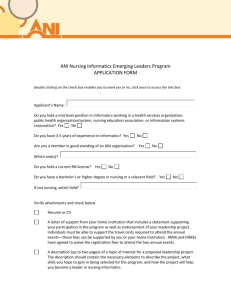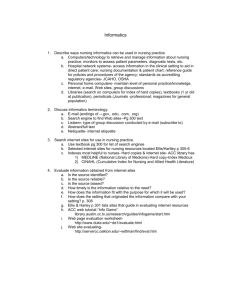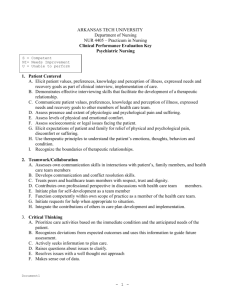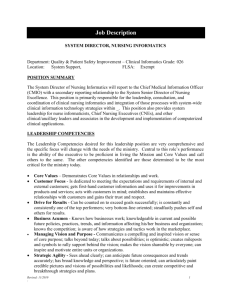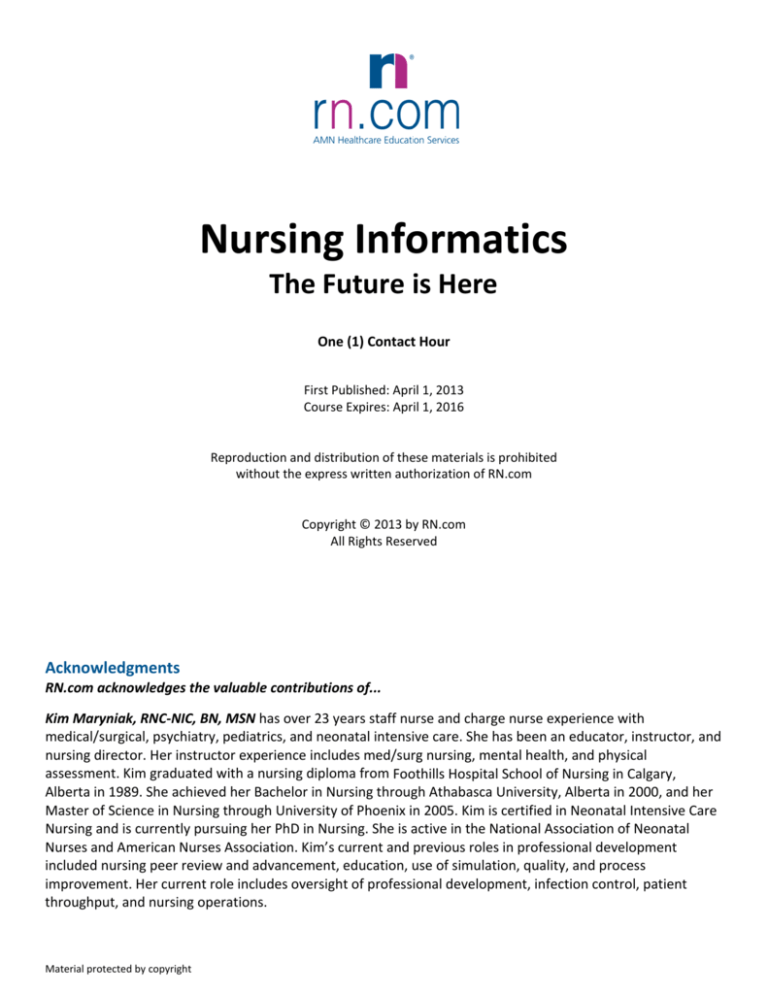
Nursing Informatics The Future is Here One (1) Contact Hour First Published: April 1, 2013 Course Expires: April 1, 2016 Reproduction and distribution of these materials is prohibited without the express written authorization of RN.com Copyright © 2013 by RN.com All Rights Reserved Acknowledgments RN.com acknowledges the valuable contributions of... Kim Maryniak, RNC‐NIC, BN, MSN has over 23 years staff nurse and charge nurse experience with medical/surgical, psychiatry, pediatrics, and neonatal intensive care. She has been an educator, instructor, and nursing director. Her instructor experience includes med/surg nursing, mental health, and physical assessment. Kim graduated with a nursing diploma from Foothills Hospital School of Nursing in Calgary, Alberta in 1989. She achieved her Bachelor in Nursing through Athabasca University, Alberta in 2000, and her Master of Science in Nursing through University of Phoenix in 2005. Kim is certified in Neonatal Intensive Care Nursing and is currently pursuing her PhD in Nursing. She is active in the National Association of Neonatal Nurses and American Nurses Association. Kim’s current and previous roles in professional development included nursing peer review and advancement, education, use of simulation, quality, and process improvement. Her current role includes oversight of professional development, infection control, patient throughput, and nursing operations. Material protected by copyright Purpose The purpose of this course is to provide nurses with an overview and basic understanding of how informatics and information technology can be used to improve the delivery of quality patient care. Learning Objectives After successful completion of this course, you will be able to: • Define nursing informatics. • Discuss implementation of technology in healthcare. • Discuss ways in which nurses can participate in the implementation of new technology. • Describe the roles and responsibilities involved in nursing informatics. • Describe the specialty of nursing informatics and explain educational pathways to certification. Introduction Technology has increased rapidly over the past four decades, and has become an integral part of healthcare. Nurses have participated in the purchase, design, and implementation of information technology in healthcare. The knowledge required for the field of nursing informatics has expanded and it is now a recognized specialty in the profession. Nursing informatics is considered both a science and a system, including process and data. Definition of Nursing Informatics The term “nursing informatics” was initially seen in literature in the 1980s, including a definition of combining nursing, information, and computer sciences for managing and processing data into knowledge for using in nursing practice (Murphy, 2010). In 1994, The American Nurses Association (ANA) began developing a statement to describe and define the scope of nursing informatics (Baker, 2012). The meaning of nursing informatics has evolved and been refined, with the American Nurses Association (2008) definition stated as “a specialty that integrates nursing science, computer science, and information science to manage and communicate data, information, knowledge, and wisdom in nursing practice” (p. 65). Another definition of nursing informatics comes from the American Medical Informatics Association (AMIA), which states “Nursing Informatics science and practice integrates nursing, its information and knowledge and their management, with information and communication technologies to promote the health of people, families and communities worldwide” (2009, para. 1). Components of Nursing Informatics It was identified by the Institute of Medicine (IOM) report in 2001 that a transformation in healthcare is needed. Included in this report was a call for the use of health information technology (IT) to enhance the quality, safety, and efficiency of healthcare. This transformation includes improving communication between providers and patients, automating clinical information, reducing errors, and promoting evidence‐based practice. •
•
Nursing informatics (NI) supports the decision‐making of patients, nurses, and other providers in all roles and settings. This assistance is achieved through the use of information structures, processes, and technology. Informatics nurses are those who have extensive clinical practice, are considered experts in using the nursing process, and have additional experience and education with technology (Healthcare Information and Management Systems Society [HIMSS], 2012). Material protected by copyright Test Yourself: Which of the following is NOT considered part of the definition of nursing informatics? a) Information science b) Social science c) Computer science d) Nursing science Theory with Nursing Informatics Theories in nursing include concepts and relationships that assist in providing framework. Theories that assist in defining nursing informatics include systems theory, cognitive theory, and change theory. •
Systems theory: Systems theory looks at interacting parts within boundaries, and can be seen with the use of technology and the body systems of patients. • Cognitive theory: Cognitive theory can be related to input, output, and processing. • Change theory: Change theory is applied in looking at the dynamic processes that are incorporated with nursing informatics. (Baker, 2012) Meaningful Use The Patient Protection and Affordable Care Act and the American Recovery and Reinvestment Act of 2009 (ARRA), includes incentive payments from the Centers Medicare and Medicaid Services (CMS) to eligible hospitals and providers for the meaningful use of certified health information technology products. Meaningful use is mandated for providers and hospitals to improve quality, safety, communication, and coordination in healthcare. There are three components of meaningful use: use of an electronic health record (EHR) in a meaningful manner, use of EHR technology for electronic exchange of information, and use of EHR technology to submit clinical quality measures (CMS, 2010). Stage one of meaningful use for hospitals includes reporting of 14 core objectives and 15 clinical quality measures, and stage two includes 16 core objectives and 6 hospital menu objectives (CMS, 2010 and 2012). Meaningful Use Hospital Menu Objectives Stage 1 •
Drug‐formulary checks •
Record advanced directives for patients 65 years or older •
Incorporate clinical lab test results as structured data •
Generate lists of patients by specific conditions •
Use certified EHR technology to identify patient‐specific education resources and provide to patient, if appropriate •
Medication reconciliation •
Summary of care record for each transition of care/referrals •
Capability to submit electronic data to immunization registries/systems* •
Capability to provide electronic submission of reportable lab results to public health agencies* •
Capability to provide electronic syndromic surveillance data to public health agencies* * At least 1 public health objective must be selected Material protected by copyright Meaningful Use Core Objectives Stage 1 •
Computerized provider order entry (CPOE) •
Drug‐drug and drug‐allergy interaction checks •
Record demographics •
Implement one clinical decision support rule •
Maintain up‐to‐date problem list of current and active diagnoses •
Maintain active medication list •
Maintain active medication allergy list •
Record and chart changes in vital signs •
Record smoking status for patients 13 years or older •
Report hospital clinical quality measures to CMS or States •
Provide patients with an electronic copy of their health information, upon request •
Provide patients with an electronic copy of their discharge instructions at time of discharge, upon request •
Capability to exchange key clinical information among providers of care and patient‐authorized entities electronically •
Protect electronic health information (CMS, 2010) Components of meaningful use through the EHR include computerized physician order entry, patient demographics, vital signs, medication reconciliation, drug interactions, allergies, smoking status, clinical decision support, interdisciplinary communications, advance directives, confidentiality, transitions of care, patient education, and ability of patients to obtain a copy of their EHR (CMS, 2010 and 2012). As the criteria of meaningful use evolve, it is essential that nurses be involved as key stakeholders in the planning, design, implementation, evaluation, and optimization of health IT (HIMSS, 2011). Nurses' Involvement in New Technology The environments in healthcare have encompassed more than just a physical location. There is an increase in the use of technology such as mobile computers and wireless solutions, and automated exchanges between providers and patients. Adapting to these new environments requires a paradigm shift for how care is communicated and delivered, which requires knowledge of the evolution of new technologies. Nurses are at the center of this advancement as the professionals with the greatest amount of direct patient care. Healthcare environments now incorporate virtual office visits, online appointment scheduling and payment, mobile laboratories, and electronic medication prescribing. Nurses are also essential in helping patients set up their own personal health records (PHRs), or explaining to patients how to use a patient portal. The use of telehealth exchanges is increasing, particularly with underserved rural populations. New technologies offer access and opportunities to provide quality care to patients in remote settings. The challenge for these technologies with healthcare is ensuring that the automated solutions completely interact with one another, as well as with the healthcare professionals using those (HIMSS, 2011). Test Yourself: Meaningful use incorporates an electronic health record (EHR) for use in a meaningful manner and which two other purposes? a) Upholding core measures and submission of clinical quality measures b) Submission of clinical quality measures and protection of patient privacy c) Protection of patient privacy and electronic exchange of information d) Electronic exchange of information and submission of clinical quality measures Material protected by copyright Categories of Competencies Categories of competencies involved in nursing informatics include basic computer skills, information literacy, and information management. Nursing informatics assists nurses to communicate with all other clinical disciplines, coordinate patient care, and manage the information related to patient care and the nursing process (HIMSS, 2012). Competencies of Nursing Informatics The Technology Informatics Guiding Education Reform (TIGER) Initiative was created in 2004 to collaborate with nursing stakeholders to create a vision, action, and strategies to improve nursing education, practice, and patient care delivery through the use of health information technology. TIGER formed an Informatics Competency Collaborative, which define the competencies recommended for the NI discipline (TIGER, 2010). Competency: Basic Computer Skills Specific competencies for basic computer skills identified by TIGER include: •
Information and communication technology concepts •
Computer use and managing files •
Word processing •
Spreadsheets •
Database use •
Presentation •
Communication and web browsing Competency: Information Literacy TIGER identified specific competencies for information literacy: •
Establish the character and extent of the information needed •
Efficiently and effectively access needed information •
Appraise information and the sources critically, and integrates appropriate information into his/her knowledge base and value system •
Use information effectively, as an individual or team member, to achieve a specific purpose •
Evaluate outcomes of information use Competency: Information Management The competencies recognized for the category of information management include: • Verbalize the importance of health information systems with clinical practice. • Have knowledge of types and clinical and administrative uses of health information systems. • Ensure confidentiality of protected patient health information. • Assure access control in the use of health information systems. • Ensure the security of health information systems. • Have user skills, including navigation, decision support, and output reports. • Understand the principles of health information system use by healthcare professionals and consumers are based. Responsibilities within Nursing Informatics Nurse informatics have different roles and responsibilities in healthcare, each bringing value to the provision of patient care. Identified responsibilities of nursing informatics (HIMSS, 2012) include: • Analyze both clinical and financial data • Endorse and facilitate resource and reference access Material protected by copyright •
•
•
•
•
•
•
•
•
Deliver nursing content to standardized languages Improve continuity of care Enhance relationships between providers and patients Support cost savings and goals for productivity Sustain nursing work processes using technology Redesign clinical workflow Assist with change management Encourage provision of high quality, evidence‐based care Facilitate true interdisciplinary care Test Yourself: Categories of competencies with nursing informatics include basic computer skills, information management, and which of the following? a) Workflow redesign b) Health literacy c) Information literacy d) Leadership skills Roles within Nursing Informatics Roles for nurse informatics have grown over the years. A few examples include: • Leadership, including management and administration • Analysis • Integrity and compliance management • Consultation • Patient care coordination • Data integration • Educational and professional development • Policy development and advocacy • Research and evaluation • Systems integration • Clinical application support • Process and workflow design • Clinical transformation • Information technology security • Clinical champion • User training History of Nursing Informatics Historically, nurses who worked in nursing informatics were considered “pioneers” who frequently got into the informatics practice because they were good practitioners, were involved in IT projects as project team members or educators, or were just curious and technically competent. The role, responsibilities, and titles of these nurses were varied, and they often got into nursing informatics unintentionally (Murphy, 2010). The Nursing Informatics Specialty In 1992, the American Nurses Association (ANA) recognized nursing informatics as a specialty, which includes demonstrating a distinguished practice base, identifying educational programs, and support from nationally recognized organizations. With the increased recognition and educational programs focused on nursing informatics, the American Nurses Credentialing Center (ANCC) created a certification in nursing informatics in 1995 (Murphy, 2010). Material protected by copyright According to the ANA (2010), the criteria for recognition of a nursing specialty includes an area of practice that: • Defines itself as nursing • Is clearly defined • Has a well derived knowledge base particular to the practice of the nursing specialty • Is concerned with phenomena of the discipline of nursing • Subscribes to the overall purposes and functions of nursing The Nursing Informatics Specialty (cont) According to the ANA (2010), the criteria for recognition of a nursing specialty includes an area of practice that: • Can identify a need and demand for itself • Adheres to the overall licensure, certification, and education requirements of the profession • Defines competencies for the area of specialty nursing practice • Has existing mechanisms for supporting, reviewing, and disseminating research to support its knowledge base and evidence‐based practice • Has defined educational criteria for specialty preparation or graduate degree • Has continuing education programs or other mechanisms for nurses in the specialty to maintain competence • Is practiced nationally or internationally • Includes a substantial number of registered nurses who devote most of their professional time to the specialty • Is organized and represented by a national or international specialty association or branch of a parent organization (ANA, 2010, p. 12‐13). Educational Pathways Many educational programs now offer a major of nursing informatics, such as master’s level degrees. Some institutions offer a certificate in nursing informatics, which can be obtained with a minimum of a bachelor’s degree. Informatics can be included in programs with one or more courses, or have components of informatics integrated into the curriculum. Technology requirements are also increasing, such as online learning, simulation, the use of hand‐held mobile devices and applications. Curriculum Components Components of informatics curriculum, as described by the National League of Nursing (NLN, 2008) include: • Content about available informatics tools (documentation systems, electronic health records, bar code medication systems) • Content about informatics issues (privacy, security, confidentiality in the digital age, technological impact on workflow, patient care, outcomes) • Content about how tools in informatics can facilitate nurses’ work • Content about clinical decision support and tools to promote patient safety • Promote using hand‐held devices (such as a personal device assistant, or PDA) to find reference materials such as medical terminology, drug information, interpretation of laboratory results • Encourage use of PDAs for documentation of clinical rotations/practicum • Support using PDAs to locate evidence to support nursing practice • Use clinical information systems in clinical simulation • Incorporate assignments to find appropriate patient educational materials electronically • Include assignments to search the web for particular topics and find current evidence Material protected by copyright •
•
•
•
•
Utilize assignments to evaluate websites, especially consumer health sites Incorporate assignments to prepare presentations using software such as PowerPoint Include assignments to develop the use of spreadsheets or databases for information management Incorporate software use for creation of nursing care plans Provide web‐based discussions Certification A certification in nursing informatics is available through the American Nurses Credentialing Center (ANCC). To sit for the certification exam, nurses must meet the following criteria (ANCC, 2012, p.1): • Hold a current, active RN license within a state or territory of the United States or the professional, legally recognized equivalent in another country • Hold a bachelor’s or higher degree in nursing or a bachelor’s degree in a relevant field • Have practiced the equivalent of 2 years full‐time as a registered nurse • Have completed 30 hours of continuing education in informatics within the last 3 years • Meet one of the following practice hour requirements: • Have practiced a minimum of 2,000 hours in informatics nursing within the last 3 years • Have practiced a minimum of 1,000 hours in informatics nursing in the last 3 years and completed a minimum of 12 semester hours of academic credit in informatics courses that are part of a graduate‐
level informatics nursing program. • Have completed a graduate program in nursing informatics containing a minimum of 200 hours of faculty‐supervised practicum in informatics Test Yourself: Components of nursing informatics can be incorporated into curriculum by which of the following examples? a) Use of clinical simulation b) Providing assignments with web‐based searches for evidence c) Encouraging students to use PDAs d) All of the above Opportunities in Nursing Informatics The opportunities in nursing informatics include all specialties in acute care, home health, ambulatory care, long‐term care, outpatient settings, telehealth, software development, and redesign of work flows. The HIMSS made recommendations for nursing informatics based on the IOM report. These suggestions include involvement in leadership, education, and practice for nursing. • Leadership: With leadership, HIMSS proposes partnership with nurse executives to lead technological changes that promote health and healthcare delivery, support the development of informatics departments, and foster the development of the Chief Nursing Informatics Officer role. • Education: For education, suggestions include transformation of nursing education to include informatics competencies and behaviors at all levels of academic preparation, and promotion of continuing education of all levels of nursing, particularly in the areas of health IT and EHRs. • Practice: Recommendations for nursing informatics with practice include incorporating informatics competencies into practice standards, and facilitating the collection and analysis of healthcare workforce data by collecting from existing heath IT systems (HIMSS, 2011). (HIMSS, 2011). Material protected by copyright Applying Nursing Informatics •
•
•
•
Practice: knowledge of nursing information systems can be used with nursing practice such as patient documentation, monitoring devices, developing and implementing care plans and pathways, retrieval of previous records and imaging, use of telehealth, and access to current practice standards. Administration: information systems are used with communication, staff scheduling systems, cost and budget analysis, and monitoring of trends with quality and satisfaction data. Education: informatics and technology has applications in education, including simulation, electronic learning, teleconferencing, and software availability for educational presentations and programs. Research: internet capabilities and electronic databases provide rich access to obtaining, compiling, and conducting research (Baker, 2012). Conclusion The profession of nursing is viewed as both an art and science. Evolution of nursing includes evidence‐based practice and rapid incorporation of advances in technology. Nursing informatics is a field that has widespread uses in healthcare, including specialty practice. Numerous roles have developed based on the growing education and applications of the nursing informatics knowledge base. Educational curriculum and certification are options for nurses to pursue in this exciting field. Resources •
American Nurses Credentialing Center (ANCC): www.nursecredentialing.org •
Centers for Medicare and Medicaid Services (CMS), Meaningful Use: http://www.cms.gov/RegulationsandGuidance/Legislation/EHRIncentivePrograms/Meaningful_Use.html •
Healthcare Information and Management Systems Society (HIMSS): www.himss.org •
Technology Informatics Guiding Education Reform (TIGER): www.tigersummit.com References •
American Nurses Association (ANA). (2008). Nursing informatics: Scope and standards of practice. Silver Spring, MD: Nursebooks.org. •
American Nurses Association (ANA). (2010). Recognition of a nursing specialty, approval of a specialty nursing scope of practice statement, and acknowledgment of specialty nursing standards of practice. Retrieved February 24, 2013 from http://www.nursingworld.org/MainMenuCategories/ThePracticeofProfessionalNursing/NursingStandards/3‐S‐
Booklet.aspx •
American Nurses Credentialing Center. (2012). Informatics nursing certification. Retrieved February 13, 2013 from www.nursecredentialing.org/NurseSpecialities/Informatics.aspx •
American Medical Informatics Association. (2009). Nursing informatics. Retrieved February 25, 2013 from http://www.amia.org/programs/working‐groups/nursing‐informatics •
Baker, J. (2012). Nursing informatics. Perioperative Nursing Clinics, 7, 151‐160. •
Centers for Medicare and Medicaid Services. (2010). Medicare and Medicaid EHR incentive program. Retrieved February 23, 2013 from http://www.cms.gov/RegulationsandGuidance/Legislation/EHRIncentivePrograms/Downloads/MU_Stage1_ReqOver
view.pdf •
Centers for Medicare and Medicaid Services. (2012). Stage 2 eligible and critical access hospital (CAH) meaningful use core and menu objectives. Retrieved February 23, 2013 from http://www.cms.gov/RegulationsandGuidance/Legislation/EHRIncentivePrograms/Downloads/Stage2_MeaningfulU
seSpecSheet_TableContents_EligibleHospitals_CAHs.pdf Material protected by copyright •
Cipriano, P. (2011). The future of nursing and health IT: The quality elixir. Nursing Economics, 29(5), 286‐290. •
Healthcare Information and Management Systems Society. (2011). HIMSS nursing informatics position statement. Retrieved February 13, 2013 from http://www.himss.org/handouts/HIMSSNIPositionStatementMonographReport.pdf •
Healthcare Information and Management Systems Society. (2012). Nursing informatics 101. Retrieved February 13, 2013 from www.himss.org •
Institute of Medicine. (2001). Crossing the quality chasm: A new health system for the 21st century. Washington, DC: National Academies Press. •
National League of Nursing. (2008). Headlines from the NLN: Informatics in the nursing curriculum: a national survey of nursing informatics requirements in nursing curricula. Nursing Education Perspectives, 29(5), 312‐317. •
Murphy, J. (2010). Nursing informatics: The intersection of nursing, computer, and information sciences. Nursing Economics, 28(3), 204‐207. •
Technology Informatics Guiding Education Reform. (2010). The TIGER initiative: Informatics competencies for every practicing nurse: Recommendations from the TIGER collaborative. Retrieved February 15, 2013 from www.tigersummit.com Disclaimer This publication is intended solely for the educational use of healthcare professionals taking this course, for credit, from RN.com, in accordance with RN.com terms of use. It is designed to assist healthcare professionals, including nurses, in addressing many issues associated with healthcare. The guidance provided in this publication is general in nature, and is not designed to address any specific situation. As always, in assessing and responding to specific patient care situations, healthcare professionals must use their judgment, as well as follow the policies of their organization and any applicable law. This publication in no way absolves facilities of their responsibility for the appropriate orientation of healthcare professionals. Healthcare organizations using this publication as a part of their own orientation processes should review the contents of this publication to ensure accuracy and compliance before using this publication. Healthcare providers, hospitals and facilities that use this publication agree to defend and indemnify, and shall hold RN.com, including its parent(s), subsidiaries, affiliates, officers/directors, and employees from liability resulting from the use of this publication. The contents of this publication may not be reproduced without written permission from RN.com. Participants are advised that the accredited status of RN.com does not imply endorsement by the provider or ANCC of any products/therapeutics mentioned in this course. The information in the course is for educational purposes only. There is no “off label” usage of drugs or products discussed in this course. You may find that both generic and trade names are used in courses produced by RN.com. The use of trade names does not indicate any preference of one trade named agent or company over another. Trade names are provided to enhance recognition of agents described in the course. Note: All dosages given are for adults unless otherwise stated. The information on medications contained in this course is not meant to be prescriptive or all‐encompassing. You are encouraged to consult with physicians and pharmacists about all medication issues for your patients. Material protected by copyright

